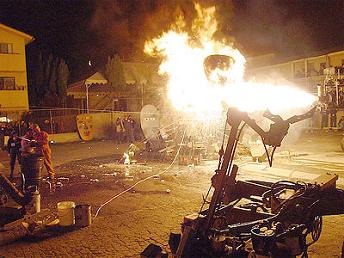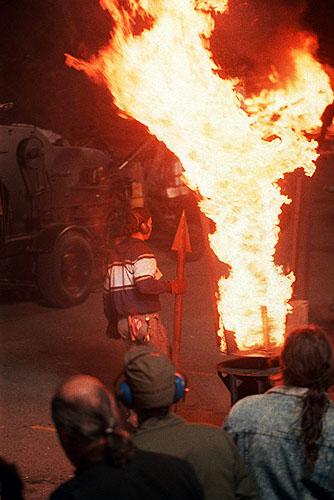
PHOTO: SRL MAYHEM. CREDIT/COPYRIGHT: Scott Beale/Laughing Squid; ALL RIGHTS RESERVED.
Mark Pauline and his dozen-odd, mostly male co-workers have stockpiled an arsenal in the machine shop where they live and work, on the outskirts of San Francisco’s Mission District. One device, the Low-Frequency Generator, is a mobile, radio-controlled, reaction jet engine, modeled after the V-1 buzz bomb whose banshee shriek struck terror in Londoners during World War II. “We ran it and people heard it almost 12 miles away,” says Pauline, with relish. “They had stories on the evening news asking anybody with information about the strange reverberations felt throughout the Bay Area to call the police. You can stand next to this thing and what it does to your brain is just…sublime. You feel as if there are rats in your chest. It shakes your eyeballs so much that they black out and come on again 45 times per second, creating a strobe effect. It’s the sort of phenomenon that doesn’t exist anywhere else on Earth.”
Another shameless wallow in ’90s nostalgia: a lengthy book excerpt uploaded to SCRIBD, this one from Escape Velocity: Cyberculture at the End of the Century.
READ IT HERE.
BUY IT HERE.
From the SCRIBD blurb (written, again, in the Bob Dole-ian third person):
Although it was published in 1996, on the eve of the Digital Revolution, Escape Velocity: Cyberculture at the End of the Century stands the test of time.
To be sure, some of its references have passed their sell-by dates, but much of Dery’s cultural critique of the ideologies of digital subcultures—their political myths and religious subtexts—still rings true. Escape Velocity explores the ’90s digital subcultures and popular movements that both celebrated and critiqued a newly wired world: cyberpunk SF, technopagans, transhumanists, cyber-hippies, and rogue roboticists such as Mark Pauline’s Survival Research Laboratories, to name a few.

PHOTO: CREDIT/COPYRIGHT SURVIVAL RESEARCH LABORATORIES.
In this chapter excerpt, “Mark Pauline: Heavy Metal Theater of Cruelty,” Dery considers the hidden agendas of Mark Pauline’s Survival Research Laboratories, a gang of renegade technologists who enact their dissident politics literally, reanimating castoff military-industrial machinery in the service of cyberpunk performance art.
In SRL’s mechanical spectacles, amok robots and humans menaced by heavy machinery dramatize popular anxieties over the growing autonomy of intelligent machines and the seeming obsolescence of humanity. SRL has perfected a heavy metal theater of cruelty—scary, stupefyingly loud events in which remote-controlled weaponry, computer-directed robots, and reanimated roadkill do battle in a murk of smoke, flames, and greasy fumes.
A combination of killing field and carnival midway, SRL’s theater of operations can be seen as a meditation on the game-like nature of military strategy, an object lesson in the theatrical unreality of war, or a black comedy about arms proliferation. “SRL shows are a satire of kill technology, an absurd parody of the military-industrial complex,” says Pauline.
